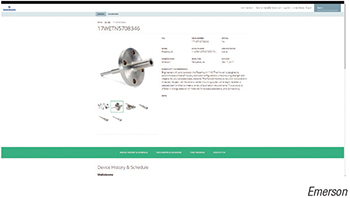Improve schedule compliance and first-time fix rate
 Last December, this company added MyAssets toolset to its MyEmerson personalized digital experience to help users execute their maintenance plans more effectively. As part of the MyEmerson digital tools portfolio launched last year to improve productivity and collaboration, MyAssets provides instant access to device documentation, replacements, spares and walkdown reports to help plant personnel better maintain and manage the useful life of their devices. For maintenance planners, MyAssets improves schedule compliance with a single location for device information, technical documentation, spare and replacement part details and lifecycle status condition. Easy access to curated, relevant device content enables faster creation of work packets, reducing time from hours to minutes. Digital walkdown reports provide detailed analyses of a site’s device conditions — regardless of manufacturer — and prioritized recommendations for next steps, guiding faster and more predictable shutdowns, turnarounds and outages. — Emerson, St. Louis, Mo.
Last December, this company added MyAssets toolset to its MyEmerson personalized digital experience to help users execute their maintenance plans more effectively. As part of the MyEmerson digital tools portfolio launched last year to improve productivity and collaboration, MyAssets provides instant access to device documentation, replacements, spares and walkdown reports to help plant personnel better maintain and manage the useful life of their devices. For maintenance planners, MyAssets improves schedule compliance with a single location for device information, technical documentation, spare and replacement part details and lifecycle status condition. Easy access to curated, relevant device content enables faster creation of work packets, reducing time from hours to minutes. Digital walkdown reports provide detailed analyses of a site’s device conditions — regardless of manufacturer — and prioritized recommendations for next steps, guiding faster and more predictable shutdowns, turnarounds and outages. — Emerson, St. Louis, Mo.